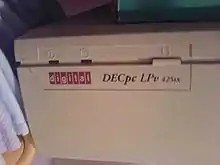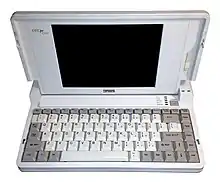
DECpc wordmark
DECpc was a wide-ranging family of desktop computers, laptops, servers, and workstations sold by Digital Equipment Corporation. The vast majority in the family are based on x86 processors, although the APX 150 uses DEC's own Alpha processor. The line was DEC's first big break into the IBM PC compatible market.[1]
Some entries in the desktop DECpc range were built by Olivetti S.p.A. and Tandy Corporation.[1]
Line-up

Close-up of a DECpc LPv 425sx

DECpc 320P

DECpc 425SE Color
- Explanatory notes
- † Upgradable with snap-in processor/cache daughtercard[2]
- ‡ Advanced Power Management–compliant[3]
Desktops
| Model | Processor | Clock speed | Form factor | Drive bays | Bus architecture | Expansion slots | Date introduced |
|---|---|---|---|---|---|---|---|
| 333sx LP | 386SX | 33 | Small-form-factor desktop | 2 × 5.25-in (1 internal) 1 × 3.5-in | ISA, VLB | November 1992[2] | |
| 340dx LP | 386DX† | 40 | Small-form-factor desktop | 2 × 5.25-in (1 internal) 1 × 3.5-in | ISA, VLB | November 1992[2] | |
| 425sx LP | 486SX† | 25 | Small-form-factor desktop | 2 × 5.25-in (1 internal) 1 × 3.5-in | ISA, VLB | November 1992[2] | |
| 433dx LP | 486DX† | 33 | Small-form-factor desktop | 2 × 5.25-in (1 internal) 1 × 3.5-in | ISA, VLB | November 1992[2] | |
| 450d2 LP | 486DX2† | 50 | Small-form-factor desktop | 2 × 5.25-in (1 internal) 1 × 3.5-in | ISA, VLB | November 1992[2] | |
| 466d2 LP | 486DX2† | 66 | Small-form-factor desktop | 2 × 5.25-in (1 internal) 1 × 3.5-in | ISA, VLB | November 1992[2] | |
| LPv 425sx | 486DX† | 25 | Small-form-factor desktop | 2 × 5.25-in (1 internal) 1 × 3.5-in | ISA, VLB | August 1993[4] | |
| LPv 433dx | 486DX | 33 | Small-form-factor desktop | 2 × 5.25-in (1 internal) 1 × 3.5-in | ISA, VLB | 3 | 1993[5] |
| LPv 450d2 | 486DX2 | 50 | Small-form-factor desktop | 2 × 5.25-in (1 internal) 1 × 3.5-in | ISA, VLB | 3 | 1993[5] |
| LPx 433sx | 486SX | 33 | Full desktop | 3 × 5.25-in 1 × 3.5-in | ISA, VLB | 1993[6] | |
| LPx 433dx | 486DX | 33 | Full desktop | 3 × 5.25-in 1 × 3.5-in | ISA, VLB | 1993[6] | |
| LPx 450d2 | 486DX2 | 50 | Full desktop | 3 × 5.25-in 1 × 3.5-in | ISA, VLB | 1993[6] | |
| LPx 466d2 | 486DX2 | 66 | Full desktop | 3 × 5.25-in 1 × 3.5-in | ISA, VLB | 1993[6] | |
| MTE 433dx | 486DX | 33 | Mini-tower | 5 × 5.25-in 1 × 3.5-in | EISA | 5 | 1993[7] |
| MTE 466d2 | 486DX2 | 66 | Mini-tower | 5 × 5.25-in 1 × 3.5-in | EISA | 5 | 1993[7] |
| ST | Full tower | 5 × 5.25-in 1 × 3.5-in | EISA | 8 (2 proprietary) | 1993[8] | ||
| LPv+ 425sx | 486SX | 25 | Small-form-factor desktop | 2 × 5.25-in (1 internal) 1 × 3.5-in | ISA, VLB‡ | 3[9] | January 1994[3] |
| LPv+ 433sx | 486SX | 33 | Small-form-factor desktop | 2 × 5.25-in (1 internal) 1 × 3.5-in | ISA, VLB‡ | 3[9] | January 1994[3][9] |
| LPv+ 433dx | 486DX | 33 | Small-form-factor desktop | 2 × 5.25-in (1 internal) 1 × 3.5-in | ISA, VLB‡ | 3[9] | January 1994[3][9] |
| LPv+ 450d2 | 486DX2 | 50 | Small-form-factor desktop | 2 × 5.25-in (1 internal) 1 × 3.5-in | ISA, VLB‡ | 3[9] | January 1994[3][10] |
| LPv+ 466d2 | 486DX2 | 66 | Small-form-factor desktop | 2 × 5.25-in (1 internal) 1 × 3.5-in | ISA, VLB‡ | 3[9] | January 1994[3] |
| LPv+ 4100 | 486DX4 | 100 | Small-form-factor desktop | 2 × 5.25-in (1 internal) 1 × 3.5-in | ISA, VLB‡ | 3[9] | May 1994[10] |
| LPx+ 450d2 | 486DX2 | 50 | Full desktop | 3 × 5.25-in 1 × 3.5-in | ISA, VLB‡ | May 1994[10] | |
| LPx+ 4100 | 486DX4 | 100 | Full desktop | 3 × 5.25-in 1 × 3.5-in | ISA, VLB‡ | May 1994[10] |
Laptops
| Model | Processor | Clock speed | Max. RAM (MB) | LCD technology and size (diagonal) | Manufacturer | Date introduced |
|---|---|---|---|---|---|---|
| 320P | 80386SX | 20 | 8 | Passive-matrix monochrome, 7 in | PTCC, Inc. (Tandy–Matsushita) | February 1992[11][12] |
| 325P | 80386SL | 25 | Passive-matrix monochrome, 10 in | PTCC, Inc.[13] | November 1992[14] | |
| 325SL | 80386SL | 25 | Passive-matrix monochrome, 10 in | AST Research | 1993[15] | |
| 325SLC | 80386SL | 25 | Passive-matrix color, 9.5 in[16] | AST Research | 1993[15] | |
| 425SL | 80486SL | 25 | 32 | Passive-matrix monochrome, 10 in | AST Research | 1993[15] |
| 425SLC | 80486SL | 25 | 32 | Active-matrix color, 9.5 in | AST Research | 1993[17] |
| 433SLC Premium | 80486SL | 33 | 32 | Active-matrix color, 9.5 in | AST Research | January 1994[3][18] |
| 425SE | 80486SL | 25 | 20 | Passive-matrix monochrome, 9.5 in | AST Research | January 1994[3][19] |
| 425SE Color | 80486SL | 25 | 20 | Passive-matrix color, 9.5 in | AST Research | January 1994[3][19] |
| 433SE | 80486SL | 33 | Passive-matrix monochrome, 9.5 in | AST Research | April 1994[20] | |
| 433SE Color | 80486SL | 33 | Passive-matrix color, 9.5 in | AST Research | April 1994[20] |
Workstations and servers
| Model | Processor | Clock speed | Form factor | Drive bays | Bus architecture | Expansion slots | Date introduced |
|---|---|---|---|---|---|---|---|
| XL Server 466 | 486DX2 | 66 | Full tower | 9 | EISA, PCI | 7 (4 EISA, 2 PCI, 1 proprietary, dual-use network bus) | March 1994[21] |
| XL Server 560 | Pentium | 60 | Full tower | 9 | EISA, PCI | 7 (4 EISA, 2 PCI, 1 proprietary, dual-use network bus) | March 1994[21] |
| XL Server 566 | Pentium | 66 | Full tower | 9 | EISA, PCI | 7 (4 EISA, 2 PCI, 1 proprietary, dual-use network bus) | March 1994[21] |
See also
- Digital HiNote, the successor to the DECpc line of laptops
- DECstation, concurrent line of workstations
References
- 1 2 Darrow, Barbara (May 27, 1991). "DEC Attempts to Crack PC Market". InfoWorld. IDG Publications. 13 (21): 23 – via Google Books.
- 1 2 3 4 5 6 7 Torgan, Emerson Andrew (November 10, 1992). "DEC Dives into the Low-End PC Arena with DECpc LP Line". PC Magazine. Ziff-Davis. 11 (19): 62 – via Google Books.
- 1 2 3 4 5 6 7 8 9 Quinlan, Tom (January 17, 1994). "Digital systems target desktop publishing". InfoWorld. IDG Publications. 16 (3): 29 – via Google Books.
- ↑ Stedman, Craig (August 30, 1993). "DEC PC push to take low-cost turn". Computerworld. CW Communications. 27 (35): 16 – via Google Books.
- 1 2 Rist, Oliver (December 7, 1993). "DECpc LPv". PC Magazine. Ziff-Davis. 12 (21): 200 – via Google Books.
- 1 2 3 4 Rist, Oliver (December 7, 1993). "DECpc LPx". PC Magazine. Ziff-Davis. 12 (21): 200 – via Google Books.
- 1 2 Rist, Oliver (December 7, 1993). "DECpc MTE". PC Magazine. Ziff-Davis. 12 (21): 200 – via Google Books.
- ↑ Rist, Oliver (December 7, 1993). "DECpc ST". PC Magazine. Ziff-Davis. 12 (21): 202 – via Google Books.
- 1 2 3 4 5 6 7 8 Service Maintenance Manual: DECpc LPv/LPv+ PC (PDF). Digital Equipment Corporation. January 1996. p. 9.
- 1 2 3 4 DiCarlo, Lisa (May 23, 1994). "DEC unveils 6 PCs, upgrades others". PC Week. Ziff-Davis. 11 (20): 29 – via Gale OneFile.
- ↑ Fisher, Susan E. (February 3, 1992). "DEC to offer direct-market notebook PC". PC Week. Ziff-Davis. 9 (5): 14 – via Gale OneFile.
- ↑ Garretson, Rob (June 1992). "A Notebook to Notice". PC World. IDG Publications. 10 (6): 66 – via Gale OneFile.
- ↑ Anothony, Robert; Julie Cohen (December 22, 1992). "DECpc 325P, GRiD 1660, GRiD 1755 486SLC". PC Magazine. Ziff-Davis. 11 (22): 222–223 – via Google Books.
- ↑ Wilson, Jayne (November 9, 1992). "Notebook from DEC is a battery miser". InfoWorld. IDG Publications. 14 (45): 40 – via Google Books.
- 1 2 3 Rist, Oliver (August 1993). "AST Research EL Color, AST Research 3/25SL, AST Research 4/25SL Color Plus, DECpc 325SL, DECpc 325SLC, DECpc 425SL". PC Magazine. Ziff-Davis: 148–157 – via Google Books.
- ↑ Nash, Siobhan, ed. (March 22, 1993). "Color notebooks". InfoWorld. IDG Publications. 15 (12): 72–83 – via Google Books.
- ↑ Potter, Steve (December 21, 1993). "DECpc 425SLC". PC Magazine. Ziff-Davis. 12 (22): 239–241 – via Google Books.
- ↑ Flanagan, William P. (August 1994). "DECpc 433SLC Premium". PC Magazine. Ziff-Davis. 13 (14): 189, 203 – via Google Books.
- 1 2 Wynblatt, Jodi L. (August 1994). "DECpc SE, DECpc SE Color". PC Magazine. Ziff-Davis. 13 (14): 188, 203 – via Google Books.
- 1 2 Staff writer (April 14, 1994). "DEC Gets Serious About Notebooks with DECpc SE Mono and Colour". Computer Business Review. New Statesman Media Group. Archived from the original on March 1, 2022.
- 1 2 3 Burns, Christine (March 14, 1994). "Digital and HP roll out servers". Network World. IDG Publications. 11 (11): 8 – via Google Books.
This article is issued from Wikipedia. The text is licensed under Creative Commons - Attribution - Sharealike. Additional terms may apply for the media files.